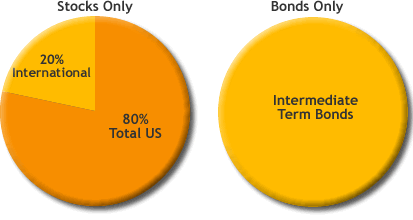All of these suggested portfolios were developed by smart people who did their homework. But none of them are the same! This is because every single one also made compromises based on their interpretation of current research, simplicity, availability of suitable investments, costs, and also to some measure their overall predictions of the future. We have to do the same thing on our end.
For example, many people are starting with smaller amounts. Some of these model portfolios have 8 funds or more! Just by the fund minimums alone, you’d be looking at a minimum balance of $24,000 or so. And even then, you’d be looking a various low balance and maintenance fees. So what do you to minimize fees? Here are a few ideas:
1) Buy an all-in-one fund, and split it up later. Since many fund companies have all-in-one target-dated funds, you can simply buy one of these until you have enough to split into other funds. Here are some specific fund suggestions, starting at only $50 per month. The fund’s asset allocation may not be exactly what you want, but it will be well-diversified, and still much better than other high-cost alternatives. Here’s what the Vanguard Target 2045 Fund looks like:

I built up about $50,000 in Vanguard Target funds (VTIVX and VTTHX) before splitting it up into 8 funds last year. Since they were held in IRAs/401ks, I didn’t have to worry about any tax consequences. This choice is my favorite because it’s the most simple – just buy the same fund for a few years!
2) Buy them one by one, like building blocks. First, you want to set a cap on how much you want to pay in expenses (expense ratio + any other fees). Maybe the cap will be 1%, which is tolerable when you are starting out (1% of $5,000 is $50).
Using your cap and the funds you want, you can determine the minimum amount of each fund you want to own. For example, you may figure it out be $5,000. Even if you want 6 funds in the end, just starting buying them one by one. After you reach $5,000 in one fund, start buying the next one. You may feel off-balance initially, but with consistent investing you will quickly reach your target allocation.
3) Buy using ETFs and a deep-discount brokerage. With ETFs, there are no low-balance fees and the fund minimum is simply the cost of one share (there are still expense ratios). Instead, you just have to worry about the transactions costs associated with the trade commission and the bid/ask spreads. If you keep your transactions large enough and use a discount broker with cheap or even free trades, you might come out ahead this way. Keep in mind that every time you want to rebalance you’ll have to pay for another commission. Or you might just realize that a few $10 low-balance fees a year really aren’t that bad 🙂
4) A variation of all three options above. Maybe you don’t like the domestic tilt of the Vanguard funds. You could start with just a Total US fund. Then add a Total International fund, and build those two up first. Then add a bond fund. Later, split up the US portion into separate funds. Finally, split up the international portion.
I hope that all made sense, there are lots of ways to do it!
 The Best Credit Card Bonus Offers – 2025
The Best Credit Card Bonus Offers – 2025 Big List of Free Stocks from Brokerage Apps
Big List of Free Stocks from Brokerage Apps Best Interest Rates on Cash - 2025
Best Interest Rates on Cash - 2025 Free Credit Scores x 3 + Free Credit Monitoring
Free Credit Scores x 3 + Free Credit Monitoring Best No Fee 0% APR Balance Transfer Offers
Best No Fee 0% APR Balance Transfer Offers Little-Known Cellular Data Plans That Can Save Big Money
Little-Known Cellular Data Plans That Can Save Big Money How To Haggle Your Cable or Direct TV Bill
How To Haggle Your Cable or Direct TV Bill Big List of Free Consumer Data Reports (Credit, Rent, Work)
Big List of Free Consumer Data Reports (Credit, Rent, Work)
One disadvantage to the “buy one fund” approach is if you have taxable accounts.
In general you’d like to buy tax-efficient funds (something like a “total market” stock fund) in taxable and buy tax-inefficient (e.g., bonds) in your tax-free/deferred accounts.
I switched my IRA from the target 2045 for exactly this reason.
Very true.
For some of the reasons Andy mentioned, I actually prefer method 4, and that’s what I’m doing right now. The problem is, because it is going to be a taxable account, splitting in the future might be very expensive (If I can manage to save lots).
It seems to me though, if your invested in the total stock market account, you should be able to keep that fund and simply adjust it by adding other asset classes to it (for instance, small cap and value). Of course there will be some overlap, but that’s kind of the point, so that that you can take that total stock market and tilt it. How do you feel about this method?
The difficulty I’ve had is that I’m not really sure how to translate the asset allocation that I want into the right amount of mixes I need for the stocks. For example, of my US equities I would like something like 50% S&P, 20 % Small/Value, but I’m not sure how much of the small/value stock I would need to supplement the total US to achieve that. It seems that you should be able to use something like Morningstar X-Ray to do this. Possibly by looking at the numbers for S&P, the numbers for Small Value and weighting appropriately? But Vanguard for example just sticks all of the numbers for VTSMX in “Blend”. Do you have any thoughts/suggestions Jonathan?